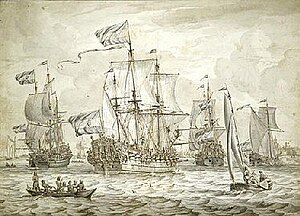Liefde (East Indiaman)
 Liefde as she may have looked | |
| History | |
|---|---|
| Name | Liefde |
| Owner | |
| Port of registry | |
| Builder | Vereenigde Oostindische Compagnie (VOC) |
| In service | 1698 |
| Out of service | 7 November 1711 |
| Fate | Ran aground and sank during a storm |
| General characteristics | |
| Class and type | VOC type frigate |
| Type | Sailing ship |
| Tonnage | 1009bm |
| Length | 48.8 metres (160 ft 1 in) |
| Crew | 300 |
| Notes | Captain Meikens Barend |
Liefde was a Dutch sailing ship that ran aground and sank during a storm in the North Sea off the Shetland Islands, Great Britain, while she was on her fourth homeward voyage from the East under the command of Captain Meikens Barend.
Owners
Liefde was built in The Netherlands by the Vereenigde Oostindische Compagnie (VOC) as a frigate for voyages to the East.
Sinking
On 7 November 1711 Liefde was on her fourth homeward voyage from the East under the command of Captain Meikens Barend and with a crew of 300. She was thought to be carrying 32 guns as well as merchandise from the east, some 227,000 guilders in bags and 1800 silver and gold ducats. After a storm hit the ship, she ran aground and sank off the Shetland Islands, Great Britain leaving only one survivor of the entire crew. This individual, whose name is unknown, lodged with a local family for about a year before being taken off the island.[1][2]
Wreck
About 2,000 guilders were salvaged by the local inhabitants during the year following the ship's sinking. In August 1965 Dutch coins were found washed ashore on the island of Housay in the Out Skerries by divers. In 1968 the remains of the wreck were discovered on the southernmost tip of the island. They lie in a cleft called Dregging Geos on the Mio Ness peninsula.[1]
References
- ^ a b Historic Environment Scotland. "De Liefde: Mio Ness, Housay, Out Skerries, North Sea (102891)". Canmore. Retrieved 5 April 2020.
- ^ "Liefde". Wrecksite. 24 September 2015. Retrieved 7 November 2015.
